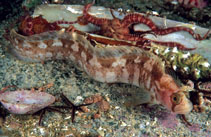| Family: |
Stichaeidae (Pricklebacks), subfamily: Chirolophinae |
| Max. size: |
25 cm SL (male/unsexed); 18 cm TL (female) |
| Environment: |
benthopelagic; marine; depth range 10 - 400 m |
| Distribution: |
Northeast Atlantic: Norwegian coast to Finmarken and Waranger Fjord, occasionally Murman coast, rare in Skagerrak, Kattegat and Öresund, around Helgoland, also British Isles; also the Orkneys, Faroes, Shetlands and Iceland (Ref. 4782). Northwest Atlantic: Canada (Ref. 7251). |
| Diagnosis: |
Dorsal spines (total): 50-54; Dorsal soft rays (total): 0-0; Anal soft rays: 35-40. Snout blunt; mouth frog-like. With a large fringed tentacle above each eye, a smaller one in front and others on top of head and on the anterior dorsal fin spines. First anal fin ray a short flexible spine. Lateral line represented by a dorsal and a mediolateral branch of neuromasts (the former begins as a short canal, with 4-5 pores. |
| Biology: |
Usually over rocks and among seaweeds, never in intertidal zone, at 20 m, but descends from 100-280 m (Ref. 4782). Benthic (Ref. 58426). Feeds on bottom invertebrates (small mollusks, polychaetes, hydroids, sponges), also algae (Ref. 4782). Spawns in October - December (Ref. 35388). |
| IUCN Red List Status: |
Not Evaluated (N.E.) Ref. (130435)
|
| Threat to humans: |
harmless |
Source and more info: www.fishbase.org. For personal, classroom, and other internal use only. Not for publication.

